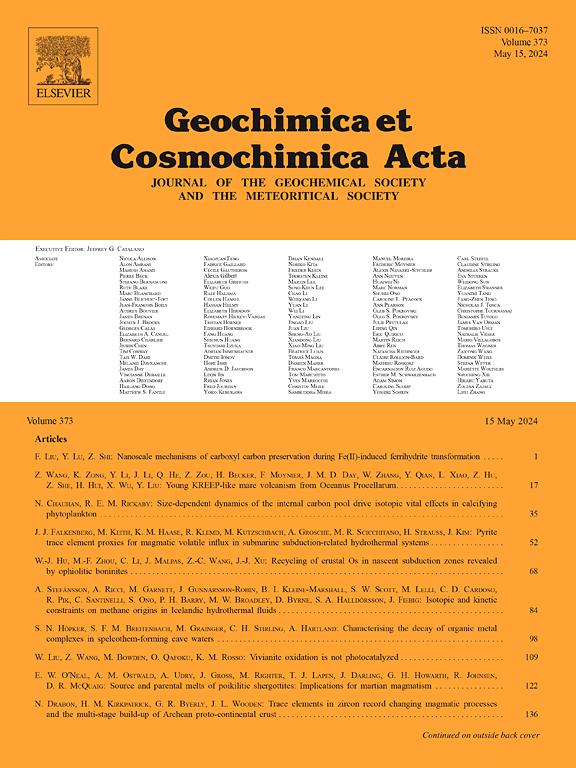地幔捕虏体中锌和铁同位素的耦合分馏:碳酸化熔体-岩石圈相互作用的记录
IF 5
1区 地球科学
Q1 GEOCHEMISTRY & GEOPHYSICS
引用次数: 0
摘要
玄武岩岩浆锌、铁耦合同位素变化是地壳物质再循环改造地幔源的潜在指标。然而,这些同位素是如何根据不同类型的地幔交代作用而分馏的,目前还没有得到很好的约束。本文对中国东北新生代碱性玄武岩中以捕虏体形式存在的直接地幔样品(橄榄岩、辉石岩及其矿物分离物)进行了高精度Zn (δ66ZnJMC-Lyon)和Fe (δ57FeIRMM-014)同位素数据和原位化学分析。根据矿物学和化学成分,这些捕虏体可分为四类。第一类橄榄岩几乎为非交代,而第二类橄榄岩表现出典型的碳酸硅酸盐熔融交代特征(如高La/Yb,低Ti/Eu)。与ⅰ组橄榄岩的正常地幔样δ66Zn(~ 0.18‰)和δ57Fe(~ 0.03‰)值不同,ⅱ组橄榄岩的δ66Zn(- 0.04‰~ 0.29‰)和δ57Fe(- 0.38‰~ 0.07‰)值变化较大,呈正相关;n = 6)。II族橄榄岩的Zn和Fe同位素组成普遍较轻,归因于碳酸化熔体入渗过程中的动力学同位素分馏。低Mg#辉石岩的δ66Zn(0.27‰~ 0.62‰)和δ57Fe(0.19‰~ 0.84‰)具有极高且正相关的δ66Zn(0.27‰~ 0.62‰)和δ57Fe(0.19‰~ 0.84‰);n = 5)。这些辉石岩被解释为碳酸化熔体的堆积物,类似于源自含循环碳酸盐的软流圈地幔部分熔融的寄主玄武岩。相比之下,高镁辉石岩(Mg# >;90)复合捕虏体表现出逐渐的模态变化,与硅酸盐熔体-橄榄岩反应的产物相一致。辉石岩δ57Fe较高(0.02‰~ 0.24‰),δ66Zn较低(- 0.05‰~ 0.03‰);N = 5)。锌、铁同位素负相关是硅酸盐熔体交代过程中扩散分馏引起的。总的来说,这些观测结果表明软流圈衍生的碳酸化和硅酸盐熔体可以通过地幔交代过程中的反应和扩散引起岩石圈地幔中Zn和Fe同位素的大量和耦合变化。因此,幔源岩石或岩浆中Zn和Fe同位素的耦合变化为追踪碳酸化熔融-岩石圈地幔相互作用提供了有价值的方法。本文章由计算机程序翻译,如有差异,请以英文原文为准。
Coupled zinc and iron isotope fractionation in mantle xenoliths: records of carbonated melt–lithosphere interaction
Coupled zinc and iron isotopic variations in basaltic magmas are potential indices of recycled crustal materials that have modified their mantle sources. Nevertheless, how these isotopes fractionate in response to various types of mantle metasomatism is not well constrained as of yet. Here we present high-precision Zn (δ66 ZnJMC-Lyon ) and Fe (δ57 FeIRMM-014 ) isotope data and in situ chemistry for direct mantle samples (peridotites, pyroxenites, and their mineral separates), occurring as xenoliths within Cenozoic alkaline basalts from northeast China. Based on mineralogical and chemical compositions, these xenoliths are classified into four groups. Group I peridotites are almost non-metasomatized, whereas Group II peridotites exhibit typical characteristics of carbonated silicate melt metasomatism (e.g., high La/Yb, low Ti/Eu). Distinct from the normal mantle-like δ66 Zn (∼0.18 ‰) and δ57 Fe (∼0.03 ‰) values of Group I peridotites, Group II peridotites have highly variable and positively correlated δ66 Zn (−0.04 ‰ to 0.29 ‰) and δ57 Fe (−0.38 ‰ to 0.07 ‰; N = 6). The generally light Zn and Fe isotopic compositions of Group II peridotites are attributed to kinetic isotope fractionation during carbonated melt infiltration. Low-Mg# pyroxenites, characterized by Mg# (100 × atomic ratio of Mg/(Mg + Fe)) of <89 and positive Eu anomalies in clinopyroxenes, have extremely high and positively correlated δ66 Zn (0.27 ‰–0.62 ‰) and δ57 Fe (0.19 ‰–0.84 ‰; N = 5). These pyroxenites are interpreted as cumulates from carbonated melts, akin to the host basalts originating from partial melting of the asthenospheric mantle containing recycled carbonate. By comparison, high-Mg# pyroxenites (Mg# > 90) display gradual modal variations in the composite xenoliths, consistent with being the product of silicate melt-peridotite reaction. These pyroxenites have higher δ57 Fe (0.02 ‰–0.24 ‰) but lower δ66 Zn (−0.05 ‰ to 0.03 ‰; N = 5) than those of the normal mantle. The negatively correlated Zn and Fe isotopic ratios were caused by diffusion-induced fractionation during silicate melt metasomatism. Collectively, these observations demonstrate that asthenosphere-derived, carbonated and silicate melts could induce substantial and coupled Zn and Fe isotopic variations in the lithospheric mantle through reaction and diffusion during mantle metasomatism. Therefore, coupled variations of Zn and Fe isotopes in mantle-derived rocks or magmas provide valuable approaches for tracing carbonated melt–lithospheric mantle interaction.
求助全文
通过发布文献求助,成功后即可免费获取论文全文。
去求助
来源期刊

Geochimica et Cosmochimica Acta
地学-地球化学与地球物理
CiteScore
9.60
自引率
14.00%
发文量
437
审稿时长
6 months
期刊介绍:
Geochimica et Cosmochimica Acta publishes research papers in a wide range of subjects in terrestrial geochemistry, meteoritics, and planetary geochemistry. The scope of the journal includes:
1). Physical chemistry of gases, aqueous solutions, glasses, and crystalline solids
2). Igneous and metamorphic petrology
3). Chemical processes in the atmosphere, hydrosphere, biosphere, and lithosphere of the Earth
4). Organic geochemistry
5). Isotope geochemistry
6). Meteoritics and meteorite impacts
7). Lunar science; and
8). Planetary geochemistry.
 求助内容:
求助内容: 应助结果提醒方式:
应助结果提醒方式:


